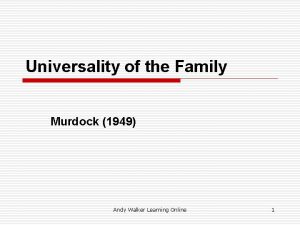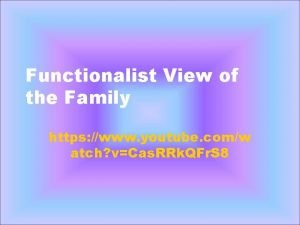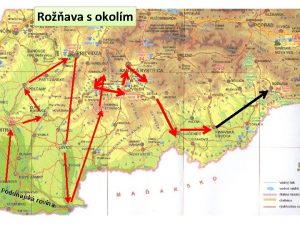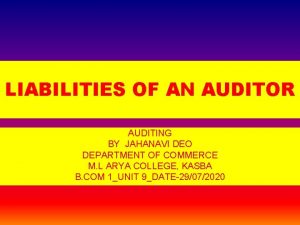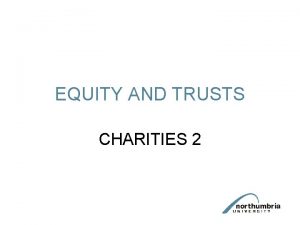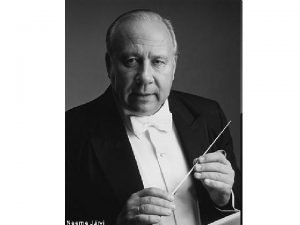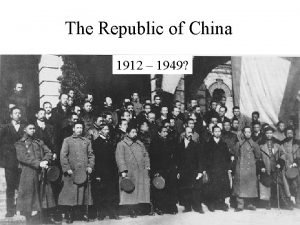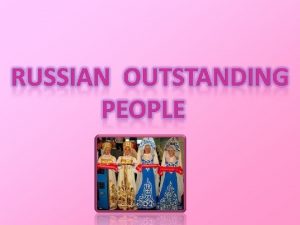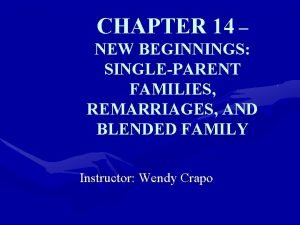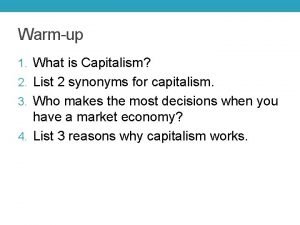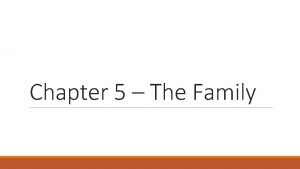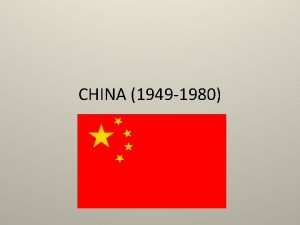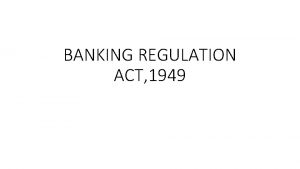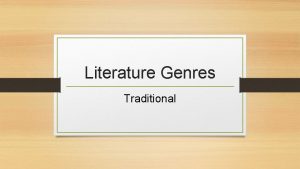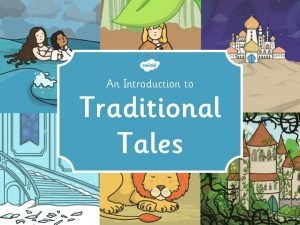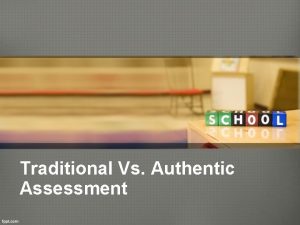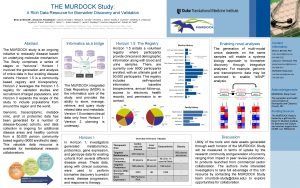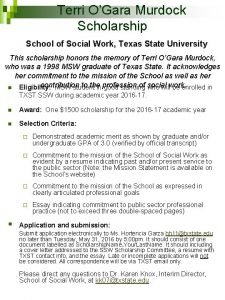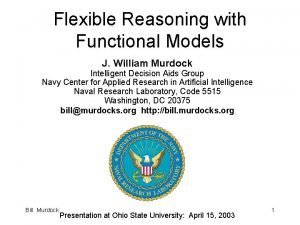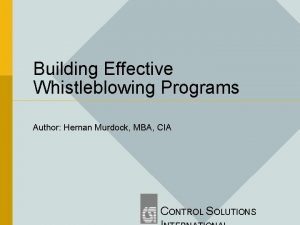Chapter 5 The Family Family Murdock 1949 Traditional

































































- Slides: 65

Chapter 5 – The Family

Family (Murdock 1949) “Traditional” Characteristics of a Family - common residence - economic cooperation and reproduction - adults of both sexes - one or more children, own or adopted Definitions often exclude newer family structures. ie- homosexual families

Family (Ambert 2003) Families involve two or more people, bound by ties of mutual consent, who assume responsibility for: - the physical maintenance and care of group members - procreation or adoption - socialization and control of children - production, consumption, and distribution of goods and services - childcare

Functionalists = families are more flexible than other social groups Types of Families Monogamy – having a single sexual or marriage partner at a time Polygamy – having more than one sexual or marriage partner at the same time (broad) - Polygyny – one man married to a number of women (specific) - Polyandry – one woman married to a number of men (specific) Marriage – union between two people, recognized by law

Households Household – residential unit consisting of one of more people that share meals and living accommodations. Single-person households – adult lives alone. . Why might this occur? Couple households – two people without children living together Shared households (communes) – group of unrelated people living together

Types of Families Nuclear Family – Family unit based on 2 generations. Parents and their dependent children ◦ Reconstituted Family – “step-family” involves the break-up of one family and reassembly as a new family through marriage or cohabitation Divorce – legal dissolution of a marriage Common-law Family – adult couple and children living together as a family without the adults being legally married. * Research Opportunity – states with Common-law marriage laws Civil Partnership – same-sex relationship giving the participants similar legal rights to married couples Partnership – being part of a couple, often living as married people but without any legal ties

Types of Families Lone-parent/Single-parent family – single parent and dependent child - lone-parent – broken nuclear family - single-parent – not the result of a family “break-up” Extended family – 3 or more generations live in the same household - matrifocal – focused on women, such as grandmother - partifocal – focused on men, such as grandfather Modified extended family – family members maintain in contact with one another, but rarely live in close contact with one another.

Activity 1. Sketch out a family tree of your extended family. Go out as far as you can, including cousins, grandparents, etc. 2. Using use as many vocabulary words as you can to label the relationships that you see. 3. Share with you neighbor.

Social Change Industrialization – machines are widely used in the production of goods. Urbanization – people moving from rural to urban areas (cities). Globalization – the movement of ideas, styles, and products around the world - political / economic / cultural globalization. . ie- EU / USA Industrialization + Urbanization – Closely Linked Globalization + Post-Industrial Society – Closely Linked post-industrial – service economy

Social Change Urbanization and Family - shift from extended families on farms to nuclear families in cities “fit” theory – argument that urbanization and industrialization contribute to changes in the family and household. Verticalized – a type of extended family that reaches up and down the generations. Grandparents, parents and children living together.

Classes in Industrial Societies Working Class - extended families - cant read or write - rely on family for support + jobs - kinship networks – family relationships, feel a bond or responsibility for each other Middle Class + Upper Class - nuclear families + extended families - education is expensive

Beanpole Family – inter-generational, vertically extended family structure with weak intergenerational ties - due to low birth rates and higher life expectancy Today with an increase in divorce, family relationships weaken. Increase in lone parent households

Diversity of Class Family Diversity – range of family types in a society - nuclear, extended, reconstituted, single-parent Working class… more commonly have - single-parent homes - children at younger age, more generations - segregated conjugal roles – clear separation of roles and duties - patriarchy - men have more power Middle Class - symmetrical – family roles are shared equally within the home - lower levels of gender inequality (debatable) - actively involved in child’s education

Ethnicity and Family Formation (UK) During a Family Formation in UK - Black women are more likely to remain in “full-employment” than White and Asian peers. - Indian women are more likely to take part-time employment when they have a partner - Pakistani and Bangladeshi women are more likely to completely stop working once they become married Black Caribbean Families - lower marriage rates - higher divorce rates - higher rates of cohabitation outside of marriage - higher rates of absent fathers – therefore mostly matriarchal

Other Families South Asian Families - high marriage rates (often arranged marriages especially among Muslims and Sikhs) - lower rates of cohabitation outside of marriage - much lower rates of being headed by a “lone parent“ - partiarchial

Life Cycle Pre-family – young adults leave their family of origin to begin a new family - separation – geographically, residentially, socially Family – family formation itself - roles change – parenting, grandparenting - statuses change – baby, child, adolescent, etc. Post-family – further life cycle (boomerang kids) - lack of employment - high levels of debt - lack of affordable housing - divorce

Family Size Historically – the lower the class, the higher the family size Modern Industrial Societies – trend of decreasing family size - social attitude has changed - drain on financial resources, (in past they were a financial asset - farms) - women pursue career instead of children Childhood – socially variable period of pre-adulthood

Nuclear Family Theory Murdock’s Theory (1949): “the nuclear family is a universal human social grouping” 1. Structural convergence – idea that family structures are historically moving towards the nuclear norm. This will be the sole prevailing family form. 2. Dominance – nuclear family is the main family form in all societies.

Functional “Fit” Functional Fit – the idea that social institutions such as family, education, and work are closely related. Work – family provides socialized individuals for the workplace, and work provides the physical means for family survival. – reciprocal relationship functional fit between industrial societies and nuclear families. - “isolated” nuclear families can move as the economy demands The nuclear family is the building block for all other family types. Explain this

Other Family Structures Nayar of Malabar (S. India) – matrilineal, polyandry – women occupy main house and men have separate residences Lakker of Burma – women considered to have no blood relation to child, only seen as a vessel Ashanti of West Africa – matrifocal, children legally belong to mother and her clan - family assets are owned and controlled by the female All of these are pre-industrial societies, so they do not go against nuclear family theory. The Nuclear norm has not been established yet.

Complex Marriage - USA 1800 s Boston – Shaker/Oneida Community in Boston - few hundred members - “every man married to every woman” - male-female cohabitation requires consent of third party - no two people could have exclusive attachment with each other Community was dissolved in 1881

Israel “Kibbutz” – communal living Communal living, property, child-rearing - couples could engage in monogamous sexual relationships - couples did not share common residence and economic co-operation characteristic of nuclear families - product of their work was shared among the community Kibbutzium – communal movement developed in Israel after WWII - each kibbutz functions like a family

New World Black Family Common in Caribbean and parts of the USA - matrifocal extended family - usually a single woman and children supported by extended family - often centered around grandmother Why - history of slavery, men often separated from women - extreme poverty, men live away from women because they can not support them financially men sometimes live apart but provide economic and emotional support to family - sometimes domestic violence because of male’s inadequacy to provide economically

Patrilineal Families Patrilineal – tracing ancestral descent through the male line. Why? - capitalism, passing wealth down through “legitimate heirs” - patriarchy – Marxist view (structuralism. marxist)

Family and Economy - Consensus Functionalism (consensus) – cooperation between institutions - economic - political - cultural (education, religion, media) - family For the economy to function, it needs the family to produce socialized individuals oriented towards work. Functional Prerequisites – things any institution (like family) must perform if it is to continue to function successfully. - monogamy created stability - socialization teaches values and norms - families organize for the unit’s survival – domestic/paid work

Functions Loss of functions – functions once performed by one institution are now performed by another - schools have taken over education in late-modern (late industrial) societies Primary Socialization – teaching and learning process normally carried out by the family. - social development into adulthood Core Functions – family mostly responsible for this. Provides shelter and nurturing environment. - includes primary socialization Peripheral Functions – functions taken over by institutions over time. - education, healthcare, recreation

Family and Economy - Neo-Functionalism Like functionalism but focuses on more specific processes linking the individual to society - the family functions as a bridge connecting the “micro” world of family to the “macro” world of the economy - families help us learn the social rules necessary for functioning in the wider world - family is a “school for learning social norms” - families teach us how to behave and develop relationships in the wider business world - rule learning can be taught subconsciously by children observing and imitating adult behavior

Family and Economy - Conflict Marxist Theory linking Family and Economy 1. Ideologically – children learn norms and values supportive of the status quo. - unquestioning acceptance of the ‘capitalist system’ - families teach values such as: work ethic, obey legitimate authority 2. Economically – families take on the responsibility of replacing ‘dead labor’ – die/retire/etc. - families take on the role of consumption - buying food, shelter, leisure 3. Politically - families have to work to support one another and children financially - privatized family – home-oriented, child centered. Keeps people discouraged from action against the exploitative capitalist system.

Neo-Marxism – “cultural capital”, non-economic resources that can be spent to give a class an advantage in the workplace. - attitudes towards education a lack of cultural capital is why “working-class kids” wind up getting “working-class jobs”

Social Capital + Symbolic Capital Social capital – people’s connections within a network and the value of those connections ‘norms of reciprocity’ – what people do for each other wealthy and middle class have greater access to ‘significant’ social networks - schools, workplace Symbolic Capital – characteristics developed by upper-class children - authority – directing efforts of others in the expectation of being obeyed - personal charisma – manipulating other’s behaviour

Feminism Traditionally focused on conflict within the family. - women exploited through ‘traditional gender roles’ – domestic labor, childcare – ‘free’ domestic labor Marxist Feminists – dual burden, exploited in workplace and exploited at home (domestic labor) Triple shift – dual burden + investing the time and effort in the psychological well-being of family members Feminists argue that women suffer from - patriarchy as domestic labor - capitalism as paid employees – low pay / low status

Activity P 117 1. types of capital - examples -economic -cultural -social -symbolic 2. most important factor in determining school? / marriage? / occupation? 3. Finish Surveys

Functions Family Functions – various purposes that the family group exists to perform in society - ie: socialization Socialization has changed with industrialization - learn norms and values resulting in how to deal with others instead of specific skills - family members are more connected to the outside world today Today – peer groups and media have a significant impact on socialization process - family still important though

Marriage Past – marriage for economic stability - upper class – consolidate wealth - lower class – subsistence farming, division of labor Today – marriage for emotional stability and support (love) Empty shell marriages – couple continues to live together, for reasons other than love. - marriage is effectively over

Values in Family Particularistic Values – how people such as family members or work colleagues treat others differently based on the value of their particular relationship. - ie - family members are more inclined to trust one another as opposed to a stranger Universalistic Values – values that apply to everyone, regardless of their particular situation. - ie – everyone is equal under the law

Peripheral Functions once provided by the family Changes Today Education – now handled by school system Health Care – doctors, nurses, social workers Leisure – individualistic, often outside of the family

Family and the State How the Government is involved in Family - Legal Norms, governing things such as marriage and divorce - Moral Values shaping what a family “should be” or “should do” Family ideology – family is both a public institution supported by the government, but also a private institution to be left alone to work out relationships.

The Managerial State and Family Characterized as tension between the family and the state - In modern industrial societies, the role of government is to manage the development of family groups. - Encourage behaviors such as marriage, but discourage others such as single-parenting, but does not become directly involved or coercive. (coercive – ie: china’s one child policy)

Functionalist Approach to Family and State Functionalist – families play a role in maintaining order in society - families provide essential functions for individuals and for wider society - Lets list some together…… - many of these functions have been taken over (loss of functions) by the state - Lets list some together State policies support families - VPK (free nursery school in the UK) - Child care tax credits - Affordable housing, welfare, etc.

New Right - USA New Right – “Supportive State Model” - Government supports families in performing their caretaking and human development functions Government policies directed towards supporting ‘traditional family relationships’ - married, heterosexual, dual-parent nuclear families - children given clear moral and behavioral guidance so they are less likely to engage in deviant behavior

New Right and Single Parenthood Family structures and relationships such as single parenthood can only be sustained through government support - creates a dependency culture - economic – state support allows this ‘family choice’ to exist - moral – people pick up the bill for women having children outside of marriage See single parenthood as immoral and unproductive - produces poorly socialized, dysfunctional children that go on to adult lives dependent on state benefits and crime. Dysfunctional – idea that something such as family structure is not performing its function correctly and that is harmful to the individual and society.

Conflict and the State Marxism – what the family does benefits powerful social groups - relationship between the family and the capitalist state is based on how the family helps maintain and reproduce social inequalities by presenting them as ‘normal’ and ‘natural’ - financial and moral responsibilities that people take on when they create families locks them into the capitalist structure. - people have to work to provide for family members - children are taught the ‘value’ of hard work This perspective regulates family because it is in the interests of the powerful - age for marriage - rules for divorce (some countries not allowed) - rules about bigamy and incest

Feminism and the State Feminists – family is oppressive and patriarchal - women forced into service roles such as domestic labor and childcare Feminists fight for laws and rules regarding - political representation - equal pay - anti-discrimination - domestic violence - childbirth policies of the state

Activity Poster – each showing a different perspective of the relationship between the family and the state

Activity! Family - Roles and Responsibilities Part A Groups to Present - Parents - Children and Parents - Grandparents

Conjugal Roles - Functionalism – family development is evolutionary, roles converge over time - early industrial society – male/females have asymmetrical conjugal roles - late industrial society – symmetrical roles A revolution in conjugal roles – more acceptance of equality - increased male housework - decreased female housework - men devoting more time to childcare - family group becoming more home-centered New Man – someone who combines paid work with their share of domestic labor

Conjugal Roles – Neo-Functionalism – separate roles, instrumental role – (typically men) dealing with people in an objective, unemotional way. This works with the man’s role outside of the home as provider. Expressive role – (typically women) dealing with the family on the basis of love and affection Today – Lone Parent, Same-Sex families, - these roles may be fluid and not defined Neo-Functionalists – optimum socialization of children comes from married families with complimentary roles. Not necessarily ‘traditional families’ - ‘anti-social behavior’ in children – comes from instability of roles

Family Roles - Marxism Complex conflicts and power struggles 1. how money is received, controlled, and manages before being allocated to spend. - those who control the most valuable family resource (money) have the power - who’s employment is most important, women will usually relocate for man’s job 2. moral economy – values and norms relating to the conjugal roles and responsibilities of different family members. - female can exert high levels of power through her ability to organize family resources even when the man is the only breadwinner. 3. emotional economy – affective power, feelings – if someone loves you, this gives you power. The partner that loves least can use this power.

Power Domestic Violence – any form of physical or emotional abuse towards family members within the home - aimed at controlling another family member - 75% of victims are female

Feminism and Conjugal Roles Liberal Feminism – equality of opportunity - men and women are free to choose their roles - ‘softer’ form of feminism Marxist Feminism – women “unpaid labor” at home, and “exploited” in workplace. - Economic focus Radical Feminism – Patriarchy is the primary source of male domination within family - either abandon the patriarchal family, or establish a matriarchal structure that exclude men.

Post-Feminism – an approach to understanding gender inequality that seeks to avoid a single over-arching explanation. - one should also consider class, ethnicity, etc. Post-Feminists – say that Marxist and Radical feminists ignore the change that have occurred over the past 50 years. - more women reject motherhood - women becoming career oriented (more women in college than men today) - conjugal roles are negotiated

Children’s Rights Part B Farson (1974) – ‘children’s liberation’ rights. Agree/Disagree? - See page 124

Marriage Serial Monogamy – an individual is involved in sequential sexually exclusive relationships. - breakdown of a marriage results in each partner forming a new monogamous relationship with a new partner - this skews statistics Population Patterns – Baby Boomers post-WWII ‘Peak Periods’ for marriage – high 20 s and 30 s… Getting higher over time why? Marriage rates slightly decreasing over time why? – stigma for children outside of wedlock, cohabitation, secularization

Cohabitation – two people live together as if they were married UK Stats 1986 – 10% 2006 – 25% Why? - reduced social pressure to marry - lower level of stigma attached to living together without being married - wider availability of contraception

Divorce has become more common over time Causes UK – prior to 1969 you could only divorce if you could ‘find fault’ – ie-adultery UK – 1949 – legal aid provided for divorce, accessible to working/middle classes Secularization – marriage is no longer a sacred institution to be preserved Marital Breakdown – ending a legal marital relationship for reasons other then death Factors - Young (especially teenagers) statistically more likely to divorce - Populations with a large proportion of married couples have higher divorce rates - Short Courtships – don’t get to know partner well enough

Love Romantic Love – love is unconditional, but if one person ‘falls out of love’ there is nothing to hold the marriage together Confluent Love – love is contingent, love is given in exchange for something else - ie- increase social status, money, etc. - if this fails to happen or changes, there is nothing to hold the marriage together

Childbearing Data Regarding Families - 1900 – 30 births per 1000 people - 2010 - 10 births per 1000 people Decline in family size – average of 3 to 1. 6 children Increased age where women have their first child Births outside of marriage account for about half of all births Fertility Rate – Number of children born to women of childbearing age

New Right - Concerns New Right – supports traditional families for society - moral issues, social responsibility are a focus Against Cohabitation - easier to break relationship, more promiscuous - cohabitation with children, more likely to split up - greater risk of physical/sexual abuse Critics of New Right - ‘one size fits all’ does not work in today’s society - traps people in a loveless marriage

Postmodern Optimism Postmodern Family – the focus of family members is on individual self-development - a family is whatever people want it to be - people construct relationships based on what they believe are acceptable - people write their own narrative of what a family looks like - all types of families are equal Postmodernism embraces diversity - as people are exposed to different family models, they are more tolerant and accepting - ie – gay/lesbian families over time Arguments against - see arguments for New Right

Age - Vocabulary Youth Culture – cultural norms, values, and identities particular to specific groups of young people. Ageism – discrimination based on age Dependency Ratio – relationship between the economically inactive section of a population and the economically active section. Rite of Passage – rituals that denote transitions from one phase in the life course to another.

Age - Vocabulary Age Stratification – system of social ranking by age. Ie- children have fewer rights Age Set – people of a similar age who share certain rights and responsibilities because of their age Life-course analysis – examination of differences and changes over the course of an individual’s lifetime. - experiences as a child an adult are very different.

Childhood Aries Argues – childhood is a distinctive phase of social development and is a consequence of modern societies pre-industrial society – children not treated the same, seen as “little adults” Catholic church brought about – “childlike innocence”, nurturing kids, etc. Late 1800 s brought education, children physically separated from adults

Children Dionysian child – children harbor potential evil - adults must control them Apollonian child – children are innocent and untainted by the world - adults must create conditions to nurture their goodness. Modern Industrial Society – children seen as - objects of concern requiring adult protection - autonomous possessors of rights - lacking moral consciousness - aware and accountable for their actions Adolescence – starts at puberty, ends at adulthood

Cross-Cultural Dimension Pre-Industrial Societies - children given more responsibility and accorded more rights - Adult-Child relationships were closer, less authoritative, more supportive - children encouraged to explore their sexuality Social Construction of Childhood– behavior that is culturally, rather than naturally produced - behavior is socially constructed because it varies historically and across different societies

Activity Factors affecting Childhood (p 146) Pairs Present - Class - Gender - Ethnicity Social position of the Elderly (p 148)
 Murdock 1949 family
Murdock 1949 family Murdock four functions of the family
Murdock four functions of the family Fishandkids
Fishandkids David murdock
David murdock Guillermo murdock
Guillermo murdock An auditor can be held liable under companies act 1949 for
An auditor can be held liable under companies act 1949 for Re hopkinson 1949
Re hopkinson 1949 Arthur miller 1949
Arthur miller 1949 Helilooja 1949-2001
Helilooja 1949-2001 1912-1949
1912-1949 Samson and delilah 1949
Samson and delilah 1949 Shannon weaver 1949
Shannon weaver 1949 Faiza qazi
Faiza qazi Limang tungkulin o gamit ng wika ayon kay gordon wells
Limang tungkulin o gamit ng wika ayon kay gordon wells 1954 chevrolet bel air
1954 chevrolet bel air La guerra civil china
La guerra civil china Caricature krokodil 1949
Caricature krokodil 1949 Boris mikhailovich pugachev
Boris mikhailovich pugachev Hát kết hợp bộ gõ cơ thể
Hát kết hợp bộ gõ cơ thể Lp html
Lp html Bổ thể
Bổ thể Tỉ lệ cơ thể trẻ em
Tỉ lệ cơ thể trẻ em Voi kéo gỗ như thế nào
Voi kéo gỗ như thế nào Thang điểm glasgow
Thang điểm glasgow Hát lên người ơi alleluia
Hát lên người ơi alleluia Các môn thể thao bắt đầu bằng từ đua
Các môn thể thao bắt đầu bằng từ đua Thế nào là hệ số cao nhất
Thế nào là hệ số cao nhất Các châu lục và đại dương trên thế giới
Các châu lục và đại dương trên thế giới Công thức tiính động năng
Công thức tiính động năng Trời xanh đây là của chúng ta thể thơ
Trời xanh đây là của chúng ta thể thơ Cách giải mật thư tọa độ
Cách giải mật thư tọa độ Làm thế nào để 102-1=99
Làm thế nào để 102-1=99 độ dài liên kết
độ dài liên kết Các châu lục và đại dương trên thế giới
Các châu lục và đại dương trên thế giới Thơ thất ngôn tứ tuyệt đường luật
Thơ thất ngôn tứ tuyệt đường luật Quá trình desamine hóa có thể tạo ra
Quá trình desamine hóa có thể tạo ra Một số thể thơ truyền thống
Một số thể thơ truyền thống Cái miệng bé xinh thế chỉ nói điều hay thôi
Cái miệng bé xinh thế chỉ nói điều hay thôi Vẽ hình chiếu vuông góc của vật thể sau
Vẽ hình chiếu vuông góc của vật thể sau Nguyên nhân của sự mỏi cơ sinh 8
Nguyên nhân của sự mỏi cơ sinh 8 đặc điểm cơ thể của người tối cổ
đặc điểm cơ thể của người tối cổ V. c c
V. c c Vẽ hình chiếu đứng bằng cạnh của vật thể
Vẽ hình chiếu đứng bằng cạnh của vật thể Vẽ hình chiếu vuông góc của vật thể sau
Vẽ hình chiếu vuông góc của vật thể sau Thẻ vin
Thẻ vin đại từ thay thế
đại từ thay thế điện thế nghỉ
điện thế nghỉ Tư thế ngồi viết
Tư thế ngồi viết Diễn thế sinh thái là
Diễn thế sinh thái là Dạng đột biến một nhiễm là
Dạng đột biến một nhiễm là Các số nguyên tố
Các số nguyên tố Tư thế ngồi viết
Tư thế ngồi viết Lời thề hippocrates
Lời thề hippocrates Thiếu nhi thế giới liên hoan
Thiếu nhi thế giới liên hoan ưu thế lai là gì
ưu thế lai là gì Hổ sinh sản vào mùa nào
Hổ sinh sản vào mùa nào Khi nào hổ con có thể sống độc lập
Khi nào hổ con có thể sống độc lập Sơ đồ cơ thể người
Sơ đồ cơ thể người Từ ngữ thể hiện lòng nhân hậu
Từ ngữ thể hiện lòng nhân hậu Thế nào là mạng điện lắp đặt kiểu nổi
Thế nào là mạng điện lắp đặt kiểu nổi Conjugal family
Conjugal family Varies from family to family on the periodic table
Varies from family to family on the periodic table Binuclear family vs blended family
Binuclear family vs blended family Integrated people-centred health services
Integrated people-centred health services Traditional method of performance appraisal
Traditional method of performance appraisal Traditional economy cons
Traditional economy cons
